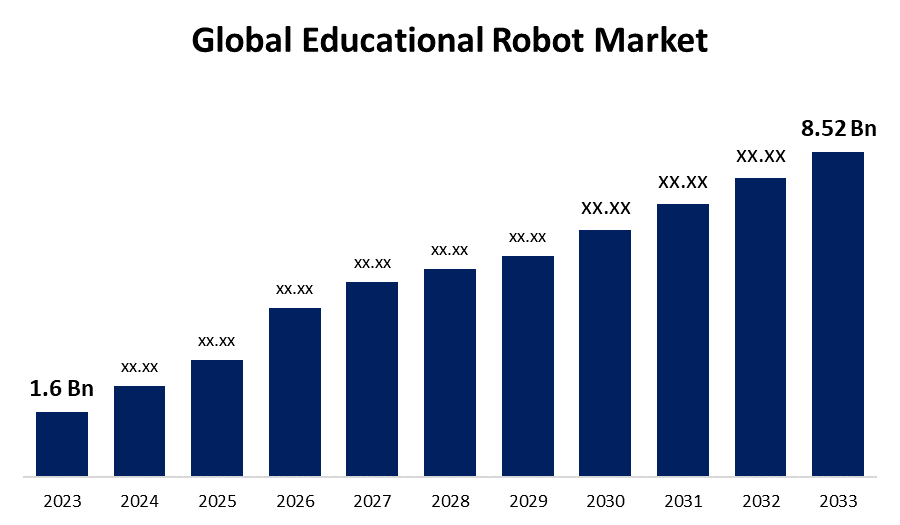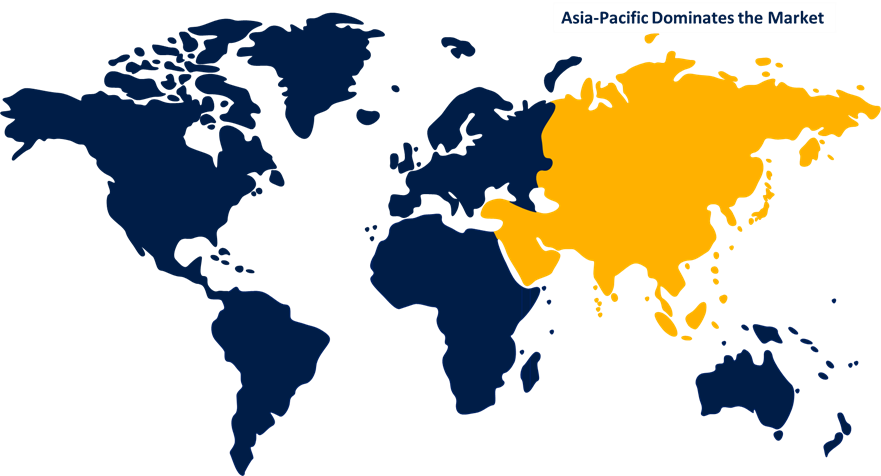Global Educational Robot Market Size, Share, and COVID-19 Impact Analysis, By Type (Programmable Robots, Humanoid Robots, Pre-build Robot, and Modular Robots), By Component (Sensors, End-Effectors, Actuators, Controllers, and Software), By Application (Higher Education and Special Education), and By Region (North America, Europe, Asia-Pacific, Latin America, Middle East, and Africa), Analysis and Forecast 2023 - 2033
Industry: Semiconductors & ElectronicsGlobal Educational Robot Market Insights Forecasts to 2033
- The Global Educational Robot Market Size was Valued at USD 1.6 Billion in 2023
- The Market Size is Growing at a CAGR of 18.2% from 2023 to 2033
- The Worldwide Educational Robot Market Size is Expected to Reach USD 8.52 Billion by 2033
- Europe is Expected to Grow the fastest during the forecast period.

Get more details on this report -
The Global Educational Robot Market Size is Anticipated to Exceed USD 8.52 Billion by 2033, Growing at a CAGR of 18.2% from 2023 to 2033.
Market Overview
An educational robot is a programmable device used for learning and teaching, particularly in science, technology, engineering, and mathematics (STEM). These robots are interactive tools that allow students to grasp complex concepts through hands-on experience. Students can learn coding, problem-solving, and critical thinking in a hands-on and pleasurable way by interacting with educational robotics. The robots frequently include customizable features, allowing teachers to tailor lessons to different age groups and learning levels. Educational robots can perform various tasks, including following instructions to complete a sequence, solving puzzles, and even interacting with students to provide feedback. In addition to STEM subjects, educational robots are used to teach language arts and social studies through storytelling and interactive lessons. Using these robots in classrooms makes learning more dynamic and engaging, encouraging students to participate and collaborate actively. As technology advances, educational robots become more sophisticated, providing more opportunities for personalized learning and becoming an essential component of modern education. They bridge the gap between theoretical knowledge and practical application, preparing students for a future in which technology is central.
Report Coverage
This research report categorizes the market for the global educational robot market based on various segments and regions forecasts revenue growth and analyzes trends in each submarket. The report analyses the key growth drivers, opportunities, and challenges influencing the global educational robot market. Recent market developments and competitive strategies such as expansion, product launch, and development, partnership, merger, and acquisition have been included to draw the competitive landscape in the market. The report strategically identifies and profiles the key market players and analyses their core competencies in each sub-segment of the global educational robot market.
Global Educational Robot Market Report Coverage
| Report Coverage | Details |
|---|---|
| Base Year: | 2023 |
| Market Size in 2023: | USD 1.6 Billion |
| Forecast Period: | 2023 - 2033 |
| Forecast Period CAGR 2023 - 2033 : | 18.2% |
| 2033 Value Projection: | USD 8.52 Billion |
| Historical Data for: | 2019 - 2022 |
| No. of Pages: | 198 |
| Tables, Charts & Figures: | 110 |
| Segments covered: | By Type, By Component, By Application, and By Region |
| Companies covered:: | ABB, Makeblock, FANUC, YASKAWA, Aisoy Robotics, Blue Frog Robotics, LEGO Systems A/S, KUKA, Universal Robots, SoftBank Robotics Group, Hanson Robotics, ROBOTIS, Robolink, UBTECH Robotics, PAL Robotics, and Others |
| Pitfalls & Challenges: | COVID-19 Empact, Challenge, Future, Growth, & Analysis |
Get more details on this report -
Driving Factors
Increasing demand for collaborative robots in the education and industrial sectors
Educational robots are becoming more affordable and simpler to program, especially for new users. They are used in two distinct contexts: research and education. Universities are researching how to use collaborative robots in various industries, including discovering new uses and applications, improving existing applications, increasing robot efficiency, and investigating robots' effects on workplace health and safety. For example, several universities worldwide are researching the use of collaborative robots in various medical procedures to assist doctors and surgeons. On the other hand, universities and community colleges are using robots to teach students the skills and technologies needed to enter the workforce. In the United States, universities like Johns Hopkins.
Restraining Factors
The high costs linked to educational robots
Industrial robots are a costly investment for educational institutions due to the cost of integration and peripherals like end effectors and vision systems.
Market Segmentation
The global educational robot market share is classified into type, component, and application.
- The programmable robots segment is expected to hold the largest share of the global educational robot market during the forecast period.
Based on the type, the global educational robot market is categorized into programmable robots, humanoid robots, pre-build robots, and modular robots. Among these, the programmable robots segment is expected to hold the largest share of the global educational robot market during the forecast period. Programmable robots are a combination of technology and education that can be used to teach robotics and programming concepts. These robots have sensors, actuators, and controls that allow humans to interact and manipulate their surroundings using preprogrammed commands. Students can use programmable robots to build simple maze-solving robots or code complex activities, providing a physical platform for learning STEM subjects engagingly and practically. Programmable robots are currently in high demand across various businesses, owing to their precision, efficiency, and adaptability. In manufacturing, these robots streamline production processes by performing tasks with unrivaled accuracy and consistency.
- The sensors segment is expected to grow at the fastest CAGR during the forecast period.
Based on the component, the global educational robot market is categorized into sensors, end-effectors, actuators, controllers, and software. Among these, the sensors segment is expected to grow at the fastest CAGR during the forecast period. Sensors play a critical role in enhancing students' understanding of engineering and robotics principles. Educational robots use a variety of sensors to enable practical learning experiences, including light sensors for detecting environmental changes and tactile sensors for gentle interactions. Students experiment with sound sensors to recognize voices, proximity sensors to avoid collisions, and navigation sensors such as GPS and compasses to move autonomously.
- The higher education segment is expected to grow at the fastest CAGR during the forecast period.
Based on the application, the global educational robot market is categorized into higher education and special education. Among these, the higher education segment is expected to grow at the fastest CAGR during the forecast period. Robotics is an crucial component of higher education that prepares students for the challenges of Industry 4.0. Robotics workshops and laboratories integrated into programs provide invaluable practical instruction and real-world experiences, developing technical, critical thinking, and problem-solving skills essential for future employment opportunities. By flawlessly incorporating robotics into the academic curriculum, higher education institutions can provide students with both theoretical knowledge and practical experience required by the changing job market. Introduction to robotics throughout the academic journey prepares graduates to thrive in the dynamic and technologically driven work environment of Industry 4.0.
Regional Segment Analysis of the Global Educational Robot Market
- North America (U.S., Canada, Mexico)
- Europe (Germany, France, U.K., Italy, Spain, Rest of Europe)
- Asia-Pacific (China, Japan, India, Rest of APAC)
- South America (Brazil and the Rest of South America)
- The Middle East and Africa (UAE, South Africa, Rest of MEA)
Asia Pacific is projected to hold the largest share of the global educational robot market over the forecast period.

Get more details on this report -
Asia Pacific is projected to hold the largest share of the global educational robot market over the forecast period. The Asia Pacific region's large educational robotics industries, as well as the growing popularity of sports. The government's coordinated efforts to raise educational standards across the region are likely to accelerate the deployment of educational robots. Furthermore, regional players' unwavering pursuit of robotics technology advancements acts as a catalyst for the incorporation of educational robots into the curriculum. Leading the way in innovation, South Korea and Japan have made significant contributions to the development of various robot types.
Europe is expected to grow at the fastest CAGR growth of the global educational robot market during the forecast period. Europe is an important location for the growth of the educational robot market because it is home to many industrialized countries with high levels of educational investment, such as Germany, the United Kingdom, France, Italy, Norway, and Sweden. Because of its proclivity to adopt cutting-edge technological solutions across a variety of industries, the region is ideal for the expansion of the educational robot market.
Competitive Analysis:
The report offers the appropriate analysis of the key organizations/companies involved within the global educational robot market along with a comparative evaluation primarily based on their product offering, business overviews, geographic presence, enterprise strategies, segment market share, and SWOT analysis. The report also provides an elaborative analysis focusing on the current news and developments of the companies, which includes product development, innovations, joint ventures, partnerships, mergers & acquisitions, strategic alliances, and others. This allows for the evaluation of the overall competition within the market.
List of Key Companies
- ABB
- Makeblock
- FANUC
- YASKAWA
- Aisoy Robotics
- Blue Frog Robotics
- LEGO Systems A/S
- KUKA
- Universal Robots
- SoftBank Robotics Group
- Hanson Robotics
- ROBOTIS
- Robolink
- UBTECH Robotics
- PAL Robotics
- Others
Key Market Developments
- In March 2023, Makeblock announced a partnership with The Douglas Stewart Company, North America's largest education distributor. This collaboration aims to increase the availability of Makeblock's educational products, such as robots and coding kits, to more schools and educators in North America.
- In January 2023, ABB Robotics collaborates with top universities to address the skills gap in robotics education. The agreements with Ho Chi Minh City (HCMC) University of Technology, Hanoi University of Technology, Da Nang University of Technology, HCMC International University, and Hanoi University of Industry include the provision of a training facility for each institution, complete with robots and simulation software.
Key Target Audience
- Market Players
- Investors
- End-users
- Government Authorities
- Consulting And Research Firm
- Venture capitalists
- Value-Added Resellers (VARs)
Market Segment
This study forecasts revenue at global, regional, and country levels from 2020 to 2033. Spherical Insights has segmented the global educational robot market based on the below-mentioned segments:
Global Educational Robot Market, By Type
- Programmable Robots
- Humanoid Robots
- Pre-build Robot
- Modular Robots
Global Educational Robot Market, By Component
- Sensors
- End-Effectors
- Actuators
- Controllers
- Software
Global Educational Robot Market, By Application
- Higher Education
- Special Education
Global Educational Robot Market, By Regional
- North America
- US
- Canada
- Mexico
- Europe
- Germany
- UK
- France
- Italy
- Spain
- Russia
- Rest of Europe
- Asia Pacific
- China
- Japan
- India
- South Korea
- Australia
- Rest of Asia Pacific
- South America
- Brazil
- Argentina
- Rest of South America
- Middle East & Africa
- UAE
- Saudi Arabia
- Qatar
- South Africa
- Rest of the Middle East & Africa
Frequently Asked Questions (FAQ)
-
1. What is the CAGR of the global educational robot market over the forecast period?The Global Educational Robot Market Size is Expected to Grow from USD 1.6 Billion in 2023 to USD 8.52 Billion by 2033, at a CAGR of 18.2% during the forecast period 2023-2033.
-
2. Which region is expected to hold the highest share in the global educational robot market?Asia Pacific is projected to hold the largest share of the global educational robot market over the forecast period.
-
3. Who are the top key players in the educational robot markers market?The top key players in the global educational robot market are ABB, Makeblock, FANUC, YASKAWA, Aisoy Robotics, Blue Frog Robotics, LEGO Systems A/S, KUKA, Universal Robots, SoftBank Robotics Group, Hanson Robotics, ROBOTIS, Robolink, UBTECH Robotics, PAL Robotics, Others.
Need help to buy this report?